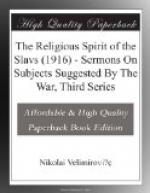Why not? Is not Christianity a revolutionary movement from its very beginning? Is it not the most wonderful and the most noble among the revolutionary movements in history? Cardinal Newman and many others spoke about the evolution of Christianity. Revolution is the word much more applicable to it. The spreading of this revolution from a poor village in Galilee over all the world—that is the history of the Church; or, if you like, the evolution of a revolution. As a volcano is an internal movement of the earth which gives a new shape to the surface, so the Christian revolution was also an internal movement, which gave a new form to the drama of human life. The Christian religion seemed very simple, it was even poor in simplicity, and still—what an incalculable impression it made! It was simple in aims and in means. It had but one aim, and there was one way only to it: to attain good only by good deeds; to fight for justice only with means that were just; to realise Love only by Love itself; to push darkness away, not by a greater darkness, but by light; to come to God the Perfect by a perfect way. Christ preached a new aim and showed a new way—a very sublime aim and a very limited way indeed. In the pre-Christian world there were manifold aims and manifold ways and means. In Sparta, skilfulness in sinning and hiding sins was tolerated and even applauded. In ancient Rome, till the full sunset of its strength, a good man was regarded as a weak man. Among the pagan Slavs, a prosperous man was envied more than a virtuous man. Christianity cleared the spiritual atmosphere and deepened human life. “Ye cannot serve God and Mammon.” It was very clear. “Narrow is the way which leads unto life.” It was very deep. Through Hell you never will reach Heaven. In making the devil your companion you will never come to God. And God is the only aim, Christ the only way to that aim; a very far aim, a very narrow way.
JAN HUSS’S REVOLUTION.
Your great compatriot, Wycliffe, is rightly considered as the beginner of the Reformation. Wycliffe spoke, and his word was his great mission on earth. But his word in Bohemia became flesh—yea, more than flesh—blood and fire. Human words are never great except when transformed into a drama—when incarnated into life. Wycliffe was never so great in England as he became




